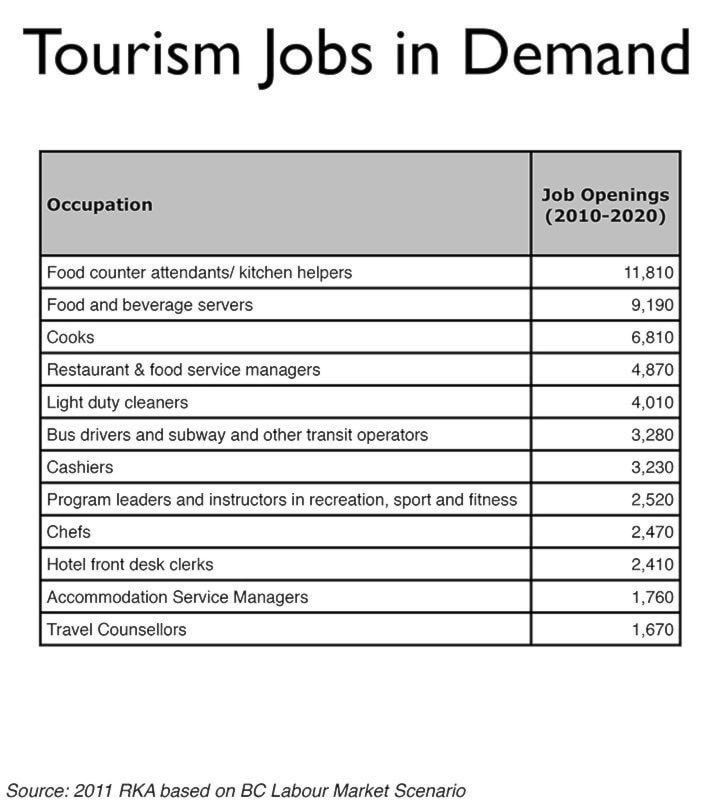For some, a dream job would be a vacation planner – for themselves! Vacationing in B.C. can take so many forms that it would indeed be a full-time job.
The tourism and hospitality industry is an extremely diverse industry with over 400 different occupations – including occupations that lead to longer-term careers, as well as those that fit well for those seeking part-time work, like students or older workers who are not yet ready to retire.
British Columbia’s tourism industry will be a leader in provincial job growth as businesses look to fill 101,000 new job openings by 2020, according to a study of labour demand and supply by go2, the BC tourism industry’s human resource association.
The Tourism Labour Market Strategy, released in the spring of 2012 by go2, sets out the plan to recruit, retain and train the workers needed to keep pace with the growth projected for the industry. Nearly half of the 101,000 openings will be new jobs created by the tourism industry across the province, adding 44,220 more jobs to the provincial workforce by 2020. The other approximately 57,000 openings are due to replacements (i.e. retirements).
“The labour strategy co-ordinated by go2 is a key pillar of industry growth in the province. Without it, we simply wouldn’t have the skilled workers in place to deliver the visitor experience throughout BC,” says Lana Denoni, Chair of TIABC, the Tourism Industry Association of British Columbia.
British Columbia’s location, bordered by the Rocky Mountains on the east and the Pacific Ocean on the west, makes it unique within Canada. Its mountain and coastal scenery, opportunities for summer sailing, winter skiing, and other activities such as fishing or sightseeing in coastal or inland waters or experiencing our vibrant cities all make us a world-class destination.
Tourism helps to diversify our economy and also brings new community services to permanent residents.
B.C.’s tourism and hospitality industry is now the single largest “primary resource industry” in the province, generating an annual real GDP ($2002) of more than $6.4 billion in 2010, ahead of forestry, mining, oil and gas extraction, and agriculture.
Tourism and hospitality generated $13.4 billion in annual revenue in 2010. Overall, between 2004 and 2010, industry revenues grew by a total of 25.5 per cent, representing an average annual growth rate of 4.2 per cent.
The provincial government’s Gaining the Edge: A Five-year Strategy for Tourism in British Columbia targets revenue growth of five per cent a year that will top $18 billion in tourism spending by 2016.
The fastest growing sectors for tourism job growth over the next decade are expected to be recreation and entertainment and travel services.
There are an estimated 17,943 tourism-related businesses across the province, employing about 260,000 workers, or 10.8 per cent of B.C.’s total labour force of 2.4 million people.
More than 80 per cent of tourism’s new job openings are projected to come in Food and Beverage Services (43,410 openings), Recreation and Entertainment (20,530 openings) and the Accommodation sector (18,920 openings).
“After several years of slow labour growth, the tourism industry is poised to expand,” said Arlene Keis, Chief Executive Officer of go2. “Labour shortages are already being felt in places like Northern B.C., the Thompson Okanagan and in the Rockies regions. By 2016, the crunch will be more acute throughout the province.”
“The tourism industry often provides people with their important first job and sets them on their career path,” said Keis. “Tourism is also the largest employer of youth, with one in four British Columbians under the age of 24 working in the industry.”
“This anticipated growth in tourism reinforces the need to plan carefully and ensure that there are enough workers with the right skills in the right communities to meet the tourism industry’s future labour needs,” said Keis.
Boomer Gaye Dolezal of Sidney, B.C. says “Working part-time in Tourism Information was a fun way for me to use my great knowledge of Canadian cities. I often astounded visitors with the connections I could make to their hometowns.” She adds “People like to feel like welcome guests, not just tourists.”
SEE WEBSITES:
Career section of go2hr.ca: http://www.go2hr.ca/careers-tourism
Tourism Labour Market Strategy: http://www.go2hr.ca/strategy
Langley sees big benefits
Tourism is an increasing contributor to the Langley economy.
Langley is home to a number of hotels, which get constant use by visitors to the area. The most recent large hotel to open is the Sandman Signature Hotel and Suites, on the south side of Highway 1 at 200 Street. It complements the existing Sandman Inn on the north side of the freeway, just east of 200 Street.
Several of the hotels in that area are popular destinations for visitors to the nearby Langley Events Centre, which is rapidly becoming a key tourist attraction in Langley. It hosts many provincial and national sports events, including the Continental Cup of Curling last January, which was televised nationally by TSN.
Another major draw to Langley is the equestrian industry. One of the largest attractions is the Thunderbird Equestrian Centre on 72 Avenue at 248 Street, which hosts several major horse shows each year. There are numerous smaller equestrian centres in Langley as well.
Agri-tourism has become a larger industry in recent years as well, with one of the most popular attractions being Langley’s many estate wineries.
Tourism Langley (www.tourism-langley.ca), located at the Events Centre, has a number of packages for tourists who are visiting Langley.
Tourism-related jobs have been on the upswing in this community, and that trend is expected to continue.
